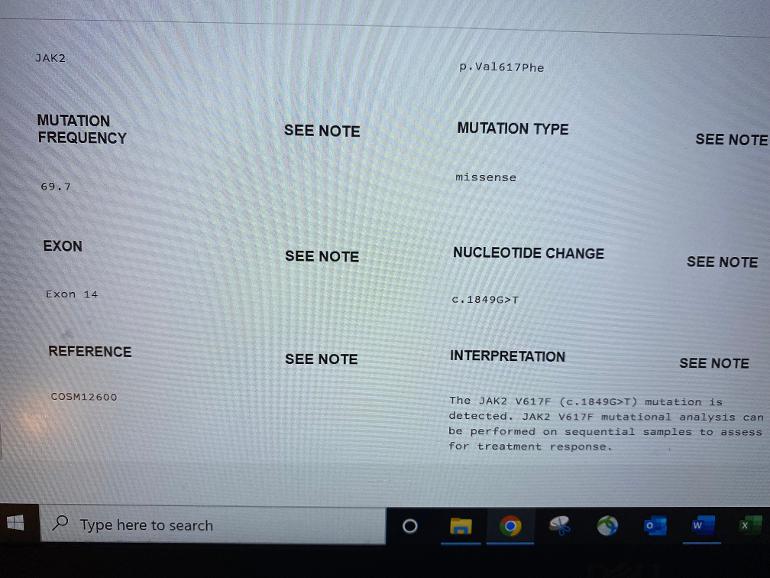Testing in January of 2022 just prior to the first Besremi injection.
Is Mutation Frequency the same as Allele Burden? Please see attached lab results
Thanks.

Testing in January of 2022 just prior to the first Besremi injection.
Is Mutation Frequency the same as Allele Burden? Please see attached lab results
Thanks.
It is the same, your "AB". Mine reads "Mutation Allele Frequency" The p.val617phe is an older way to say the more familiar V617F, from what I found before. The c.1849G>T is also on mine.
At that relatively high value, it's likely Homozygous, this type, on average, responds well to INF compared to heterogygous. Our tests rarely report this info however.
Is there any note about looking/finding other mutations?
For EPGuy,
No notes for the JAK2 test of January 2022.
However, for the notes of March 2018 in my initial diagnosis:
"Based on sequence analysis, both alleles showed JAK2 V617F
mutation. However, the possibility of hemizygous (mutation
in one allele and deletion of the second allele) cannot be
ruled out. Reflex testing for JAK2 EXON 12 and EXON 13 will not be
performed." After Google reading of homo/hetero/hemi zygous definition, I am very confused of this statement regarding which type of allele I have.
Also, No CALR, No MPL S505, No MPL W515 mutation in my initial diagnosis.
Thanks for asking.
"Both alleles" points to homozy, which is consistent. When both of the pair are mutated there is double the number of alleles, so AB tends to be higher.
I don't know much about this but my understanding is alleles are in pairs, like DNA pairs. We may have only one of the Jak2 pair mutated (heterozy, meaning each side of the pair is different), or both mutated (homozy, both alleles are mutated).
hemizygous is new to me, looking it up, seems to mean one allele of the pair is missing (hence the "deletion") Your report says you could have this rather than homozy, hence the uncertainty, but your Dx is most likely homozy Jak2 since hemizygous is just a "possibility"to be ruled out.
--
In my simplified understanding, putting it all together
- Homozy is both of the pair (every) Jak2 has the same mutation (V617F in this case) ; Heterozy is both Jak2's are present but one is normal the other is mutated with V617F, hemizygous is one of the pair is missing and the other presumably is mutated with V617F.
The reports on hemizygous for Jak2 MPN are largely ~2006 vintage, this is just after Jak2 was discovered and suggests it's not an active area of research. So not much modern info on it. In contrast Homozy vs heterozy is discussed in more recent reports in context of INF response.
It seems you did not get nexgen sequencing. Here they look for other mutations, TET2, DNMT3A, and over 100 others. This is worth having for future reference.
--
From one guide mentioning hemizygous:
Homozygous or hemizygous mutation is often seen in PV and PMF, whereas heterozygous mutation is common in ET and is associated with a lower mutant allele burden
uncmedicalcenter.org/app/fi...
--
"Reflex test" means they move on to that test when the 1st tests are not positive, ie if they don't find v617f(exon 14) they will look for Jak2 Exon 12 (and CALR, MPL if ET is suspected). One member here has both types of Jak2s but that is very rare.
Hi EP GuyThanks for these notes. I think that in the future when more is understood about the MPNs, this type of information will be significant, and it will explain why different people have different responses to treatments. If more personalised treatment/drug regimes occur in the future, I think that this type of information will be the basis of choices made by treating specialists. It could be some way down the track though. First we need a good understanding of the disease itself and how drugs influence the disease, and we don't have that yet. eg no-one knows why some people don't respond to interferons even though there was a 3 year 'Interferon Project' that tried to look into that. And also, it's not clear yet what significance allele burden has for MPNs (there's only extrapolation from other conditions). But there's probably a lot of us banking on AB being significant when we take Pegasys/Besremi. Because there's limited understanding of all this, I think that's why our haems don't go into the details of our mutation results with us too much - no-one knows what it all means, and they couldn't answer the obvious questions we'd ask anyway.
Pat, I hope that you are going well and that a deeper understanding of your results is helpful. I find the more I know the less I worry. Best wishes to you both.
Thanks MPNBlog for your comments. I hope you and everyone get better as we share our experience and thoughts about MPN. Best wishes to all!
Agree there's more questions than answers, it's more like astronomy and less like mechanical engineering.
The ~7 years Ropeg studies had good results on progression, but n of progression was small. There is some correlation of MR (molecular response) to BMR (marrow response) but the tighter correlation on INF is CHR to MR; I've posted before.
My preference is for max info at Dx on the bet that it will be useful to know years from now. My MPN specialist wants to go for AB, I think even a year or two ago he would have been less interested in that. My 1st Hem late 2020 said AB reduction was not possible.
Thanks for your insights about JAK2 alleles, and those are educational for me. It gives me better perspective of my PV disease. Bet wishes for all of us!